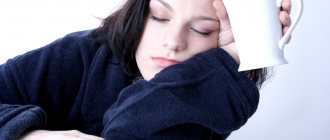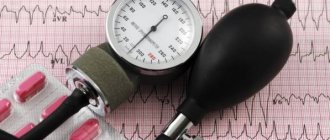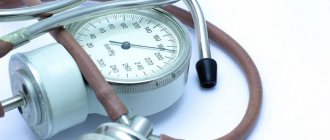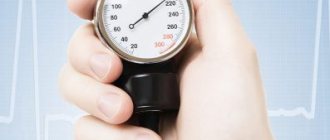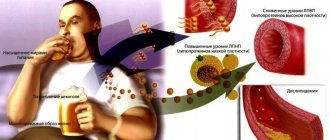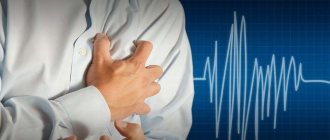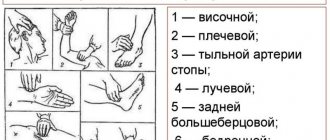With high blood pressure, the back of the head or temples hurt
Most of us sincerely believe that if you have a headache, then high or low blood pressure is always to blame.
This is a misconception, says candidate of medical sciences, neurologist Alexandra Veina Marina Vladimirovna Ryabus. — Many people naturally have constant moderate high or low blood pressure, but never complain of headaches. They feel great and sometimes perform better than those with normal blood pressure.
- But why then can those with hypertension have a headache?
— Patients suffering from high blood pressure are usually susceptible to acute and chronic stress. They painfully endure conflicts in the family and at work. They are painfully experiencing their own internal problems. And against this negative emotional background, headaches arise, which are often combined with tension in the muscles of the neck and back, and with symptoms of osteochondrosis. In other words, they are complex in nature and do not disappear even after normalization of blood pressure.
Typical headaches with hypertension are of a pressing nature, occur in the occipital region, and are often accompanied by swelling, redness of the face, and discomfort in the heart area. As a rule, they appear in the morning. They intensify after physical activity. This type of headache is directly related to an increase in pressure, but mainly lower pressure - more than 120 mm Hg. Art.
— Hypotonic people often complain of “throbbing temples,” “heaviness in the back of the head,” and migraines. They experience fainting. How do neurologists evaluate such conditions?
“None of these conditions are directly related to low blood pressure. Although it has been noted that migraines, tension headaches and other autonomic disorders are often combined with low blood pressure. Currently, a close connection between hypotension and chronic fatigue syndrome and depression has been identified. By the way, education plays an important role. For example, if a mother constantly associates her headaches with low blood pressure, then when her daughter grows up, she will also blame pressure changes for all her ailments.
With hypotension, a throbbing headache may occur due to excessive stretching of the blood vessels. And pressing from the inside on the back of the head is due to poor outflow of venous blood from the cranial cavity.
— How should you behave in everyday life if you have high or low blood pressure?
— I advise people with hypertension to evenly distribute physical activity throughout the day and carry out relaxing procedures. Get up, stretch, ventilate the room. Throw your head back, sit quietly in a chair, restore your breathing, relax the muscles of your face and body. This has a positive effect on the entire vascular pressure system, and thus a slight decrease in blood pressure can be achieved.
Hypotonic patients, on the contrary, need stimulating procedures. In the morning - a pleasant contrast shower, hot or warm tea with aromatic additives, slightly sweetened. During the day - massage of the cervical-collar area, fractional and timely meals. I emphasize that their brain should under no circumstances be deficient in active nutrients.
One more thing. All hypertensive and hypotensive patients like to associate their condition with changeable weather, magnetic storms, and solar activity. Of course, they are susceptible to weather factors, especially during the border period - from winter to summer. But to a greater extent, their malaise depends on the “weather” in their own body. Those who cope with their psychological problems react less to the weather outside the window. Believe me, this has been proven by neurological practice.
How does blood pressure affect temple pain?
Enter your pressure
130
on
90
Search in progress Not found
The appearance of pain in the temples can be caused by a hundred different reasons. Agree, almost every person has experienced such unpleasant sensations that interfere with normal activities and unsettle them. At least once in their life, every person experienced unbearable pain in the temples, which radiated to the eyes and head.
Usually this rarely happens, but if you are often overtired or do not get enough sleep, get ready, such discomfort will remain with you forever. If you lead a healthy lifestyle and generally take care of yourself, but pain appears again and again, this is a good reason to consult a specialist.
Why does your head hurt in one point on the right or left? Read more about the reasons in this article.
A common cause of such unpleasant sensations is increased blood pressure - hypertension.
According to statistics from the World Health Organization, 68% of the world's population over 30 years of age suffer from this disease.
In addition, the risk of hypertension is constantly growing every year.
If you do not treat this disease in time, with each new day your severe headache in the temple area will begin to grow: they will pulsate more strongly, put pressure on you, and radiate to the back of your head. In addition, the advanced stage of hypertension is characterized by the appearance of nausea, periodic darkening of the eyes, and pallor of the face.
Advanced arterial hypertension, which was not controlled by a specialist in time, is fraught with the formation of crises. They are accompanied by a sharp disruption of blood circulation in the brain with loss of consciousness - and this leads to serious complications.
Common reasons why temples hurt from high blood pressure include excess body weight, hormonal imbalance, and high blood cholesterol levels. Factors that provoke the appearance of pain in the temples include stressful situations, nervous experiences, weather changes, excessive exercise or alcohol consumption.
Work specifics
It often and regularly crushes the head of those who spend the working day in approximately one position. In the modern world, this applies primarily to those who communicate a lot with the computer. Even if they are provided with an ergonomic chair, the body position remains almost unchanged, so muscle groups (facial, cervical, shoulder) are fixed in it and cause headaches. It can be relieved with any analgesics, but it is better to prevent its occurrence: get up every hour and engage in alternative activities. The ideal would be industrial gymnastics, but it is probably naive to count on it...
How to deal with temple pain
Methods for eliminating temporal pain depend on the cause that caused it. It is best to contact a neurologist with this question. If you have high blood pressure, select a suitable drug for hypertension: Capoten, Enalapril and their analogues. If you suffer from migraine, take Tempalgin or Antimigraine.
In cases where the symptoms are caused by a cerebrovascular accident, the patient is given Memoplant or Cavinton. Additionally, herbal medicine or physiotherapeutic methods, for example, exercise therapy or a contrast shower, can be used.
With high blood pressure, temporal pain is usually caused by vascular spasms. Vascular tone is affected by nervous disorders, as well as atherosclerotic changes. To improve the situation and relieve spasms as quickly as possible, the doctor may prescribe Papaverine, which is sometimes combined with Phenobarbital.
Often, for pain of this nature, Dibazol is effective, improving vascular tone and gently reducing blood pressure. Such a popular antispasmodic as No-shpa can also provide emergency assistance, but it will not eliminate the cause of temporal pain. Only a specialist can help you choose a drug that will be effective in the fight against the disease and will not cause harm.
Before seeing a doctor, you can try to help yourself. Here are some ways to help cope with temporal pain:
- First of all, you can massage your temples with your index fingers on both sides. In addition, you can do acupressure with light circular movements over the entire head area;
- If possible, you need to lie down for a couple of hours with your eyes closed. In this case, it is better to turn off the lights and ensure complete silence;
- you can take a walk in the fresh air, while giving up the player and talking on the phone;
- a good remedy for pain in the temples is warm tea with chamomile;
- another proven method is a cold compress, which is applied to the forehead and temples;
- If your condition allows, you can do a little exercise. Blood will begin to circulate better and the pain will go away faster;
- for severe pain, you can apply a cut aloe leaf to your temple. At this time, it is better to lie down for about half an hour;
- A remedy that helps relieve discomfort is an infusion of cinnamon. One dessert spoon of this spice is stirred in four tablespoons of water. Then you need to add sugar to taste and leave for half an hour. Drink this mixture a couple of sips every hour. In addition, it can be used as a compress.
Other folk remedies include hot foot baths, which soothe and help relieve fatigue and pain. Valerian tincture, as well as decoctions of mint, oregano, and clover will help improve sleep. An excellent way to relieve attacks of pain is cranberry. Compotes and fruit drinks made from this healing berry improve blood circulation and bring blood pressure back to normal.
"Neurotic's Helmet"
This is what doctors call post-stress conditions, in which the temples hurt greatly. Pressure on the head, however, is felt along the entire circumference of the head, as if a tight hoop was put on it. The phenomenon is caused by prolonged emotional stress, aggravated by physical fatigue. The manifestations of the “helmet” are even stronger in those who smoke; in some cases, it is provoked by clips placed on the lobe at a certain point, or by a tight hat. Since it is quite difficult to relieve pain in such cases, doctors recommend first eliminating nervous tension: drinking tea with chamomile, doing aromatherapy, soothing self-hypnosis or breathing exercises. Head self-massage using a regular hair brush gives very good results: blood circulation in the skin increases, and the associated muscles relax quite quickly.
What is the pressure of a headache?
Based on the description of the pain syndrome, it is not always possible to determine an increase or decrease in blood pressure, since one patient may have several reasons for its occurrence at the same time - stress, venous congestion, osteochondrosis, spasm of the neck muscles, blood vessels, impaired outflow of cerebrospinal fluid.
The most typical situations are accompanied by the following manifestations:
- Hypotension - dull pressure of moderate intensity, spreading to the temples, crown and back of the head, there are attacks of pulsating beating. Occurs after overexertion, worsens after sleep, especially during the day. Accompanied by yawning, dizziness, general weakness, darkening of the eyes. The skin is pale, the palms and feet are sweating, the pulse is rapid.
- Hypertension - severe pain, squeezing, bursting, pressing, often in the back of the head, redness and/or swelling of the face, chills, tinnitus, nausea, flashing dots before the eyes. Provokes stress, prolonged physical or mental stress, change in climatic conditions.
- Increased intracranial pain - increasing acute or constant bursting pain in the frontal or parietal area, pressing on the eyes, increasing when looking to the side, blurring of the contours of objects, double vision or blurred vision occurs.
Provoking factors
The occurrence of temporal pain is influenced by various factors. The disease can lie dormant in the human body, but become more active when the weather changes, stressful situations, or time zone changes.
This often happens when there is a sudden change in diet, for example, when a person goes on a diet.
In addition, pain in the temples can be caused by uncontrolled use of medications, severe eye strain and a number of other factors. A tonometer will help tell you if there is pressure in your temples, what the pressure might be. Most often, pain in the temples occurs if blood pressure exceeds 140/90 Hg.
The frequency of pain is also of great importance. If the pain comes once a month and is quickly relieved with medications, there is no particular cause for concern. If it torments a person every day, and is also accompanied by nausea and other additional symptoms, this almost certainly indicates hypertension.
When you need to urgently go to the doctor
If the pain is not constant and goes away after taking an analgesic, then there is no particular reason for concern and an urgent trip to a specialist. Sometimes there is pressure in the temple area due to changes in atmospheric pressure and the approach of rain. It is recommended to contact a specialist in the following situations:
Do you trust doctors and their prescriptions?
Yes
20.4%
No
11.94%
I trust, but I check all medications for reviews on the Internet from people who have already tried them and only then do I start taking them.
50.25%
Yes, but only to appointments and doctors from paid clinics.
17.41%
Voted: 201
- pain has a specific location
- discomfort occurs in the morning or evening
- the painful sensation increases
- During the attack, the general condition worsens and other symptoms appear
- a headache in the temples may indicate the presence of another disease, so it is not recommended to be treated without a doctor’s prescription
The main causes and symptoms of pain in the temples with pressure
Arterial hypertension
An increase in cardiac and/or renal pressure leads to impaired cerebral circulation. High blood pressure is characterized by the following symptoms:
- pain in the temples or the back of the head, which pulsates, fetters in an iron vice.
- numbness of the scalp;
- nausea, sometimes vomiting.
High blood pressure is associated with heart and vascular diseases, kidney dysfunction, as well as excess weight and unhealthy lifestyle (smoking, alcohol abuse), and insufficient sleep and rest. Secondary hypertension is associated with diseases of the endocrine system. They lead to the fact that the thyroid gland synthesizes an excess of hormones that affect blood vessels. In a state of spasm, the blood vessel narrows and is unable to deliver oxygen to the brain. As a result, a headache appears, pressing in the temples.
Brain circulation problem
Impaired cerebral circulation depends on age, gender, climate, heredity, previous diseases, and traumatic brain injuries. In infants, the appearance of acute pain in the temples is associated with premature or complicated labor. The affected vessels of the head react sharply to changes as the child grows, intracranial pressure increases, which leads to frequent vascular spasms and stable hypertension. Over time, the elasticity of blood vessels decreases and atherosclerosis develops. Such conditions are manifested by constant weakness, periodic tinnitus, dizziness, and insomnia.
Migraine and its symptoms
Why it occurs, doctors do not answer. The difference between migraine and other types of headaches:
- nausea and vomiting, after which it becomes easier;
- duration of attacks up to several days;
- localization in one of the sides of the head, in particular in the right or left temple or forehead;
- sharp and painful perception of light and sounds;
- flickering, impaired lateral vision, numbness of the arms and legs;
- chills, weakness.
Migraine-like pain pulsates, and in a normal, comfortable position of the body is weakened.
Consequences of intoxication
Headache is also provoked by poisoning of the body with food and toxic substances. The body reacts with pain in the temples to a surge in pressure as a result of overeating chocolate, lemon, or coffee. Junk food gradually poisons the body with preservatives, food colorings, and nitrites. The blood becomes saturated with toxins, thickens, which increases the risk of a blood clot, the localization of which is indicated by pain in the temporal part of the head, attacks of nausea and vomiting.
Hormonal imbalances
A woman’s body reacts sharply to hormonal changes. Often before or during the menstrual cycle in girls, during menopause, women experience pain. The nature of the sensations is dull and aching pain lasting up to several days and rolling in waves. Most often the temples hurt; the pressure may be normal or fluctuate.
Other reasons
The course of a cold, acute respiratory viral infection or flu is distinguished not only by high body temperature, the appearance of cough and rhinitis, muscle pain and headache. When your forehead hurts or your temples pound, this indicates intoxication of the body with waste products of viruses and bacteria. The first manifestation of brain diseases, more often tumors, problems with the central nervous system is pain in the temples and forehead. Nausea, sleep disturbances, hand tremors, anxiety, and apathy are added. When the functioning of the vegetative-vascular system is disrupted according to the cerebrovascular type, a failure occurs in processes that are automatically regulated. As a result, vascular spasm develops, which increases blood pressure and causes headaches in the temples and forehead. The condition is accompanied by constant dizziness and tinnitus.
Painful enemy: migraine
According to statistics, 30 percent of the population is familiar with it. Most sufferers are between 25 and 45 years of age and are women. Moreover, pain in the left temple (sometimes on the other side) is complemented by other unpleasant manifestations: painful perception of sounds and bright light, numbness of the arms and legs, nausea, often leading to vomiting. The worst thing is that neither the causes of migraine nor the methods of getting rid of it are known to medicine. It is even impossible to predict the next attack. It is impossible to relieve migraine pain using standard methods; they can only be relieved with prescription triptans.
How to treat pain
Before you take a headache pill, you should get tested. After all, a headache in the temples can occur for serious reasons. Only after the diagnosis has been clarified, the doctor can prescribe treatment. Let's look at how to get rid of pain localized in the temporal part of the head:
- Headaches in the temples, the cause of which are migraine attacks, will help eliminate triptan drugs. The use of aspirin and analgin is completely unjustified and does not lead to improvement in the condition. Migraine occurs due to narrowing of the arteries, so treatment must be appropriate.
- If the diagnosis is VSD, vascular tone should be normalized. Physiotherapy methods help a lot. This could be swimming or at least a contrast shower in the morning. You should definitely do physical exercise. Among herbal remedies, you should choose those that normalize vascular tone. A cup of coffee or tea helps to cheer up the body. It's better if it's chamomile. If you have a severe headache, the cause may be trivial - stale air in the room. Be sure to ventilate the room, and to improve your well-being, go for a walk.
- If a patient has hypertension, increased intracranial pressure, or cerebral atherosclerosis, constant headache interferes with normal life. You should not get rid of a headache, but treat the underlying disease. Therapy aimed at lowering blood pressure is prescribed by a doctor. You will have to take medications to normalize your blood pressure for the rest of your life.
- Office workers who are bothered by headaches in the temple area can do without taking pills. During the working day, you should change your position more often, periodically get up from your workplace, and do some physical exercise. You can stretch stiff neck muscles. If the weather permits, it is better to take a break outdoors. You can relieve pain in your temples by massaging your head.
- Pain that is psychogenic in nature is best relieved with psychotherapy sessions. Additionally, the doctor may prescribe a course of aromatherapy. It is advisable to change the situation, go on vacation on a trip to the sea.
- Acute pain that is difficult to tolerate, radiating to the temples and eyes, can be relieved with non-steroidal anti-inflammatory drugs (for example, ibuprofen). These drugs reduce the inflammatory process in the patient and relieve acute pain. They provide temporary relief from pain, so long-term use is not recommended. The headache is very bad with the flu, the pain can radiate to the temporal part. Therefore, treatment should be aimed at boosting immunity and eliminating associated symptoms: cough, runny nose, headache. The patient's diet should include fresh vegetables and fruits. Especially those containing vitamin C.
Treatment
Why your head hurts and you can find out the causes of discomfort after carrying out diagnostic measures. The treatment depends on the degree of the disease and its symptoms
.
Sometimes it is enough for the patient to rub his temples with his index finger and the pain stops on its own
.
But this technique can only relieve minor pain
. Acupressure should be performed in a quiet and darkened room, using about 12 pressures on the pain points in the temples.
If you have a severe headache, you can apply hot and cold compresses directly to the temporal area. This will help you relax and relieve tension in your head in a short period of time.
. It is recommended to perform the procedure for 15 minutes. In most cases, the methods listed are enough to relieve tension and reduce the intensity of pain.
Many people do not think that when working at a computer for a long time, reading a book or driving a car, their eyes can get tired. As a result, pain appears in the temples
. If a person has such a way of life, then it is not surprising that headaches become his companion.
You need to give your eyes a rest and blink more often. When you work on the night shift, you definitely need to rest and sleep during the day. Lack of sleep accumulates and leads to the fact that the pain in the temples can be quite intense.
If you often have a headache and a pressing pain in your temples, you should consult a doctor. An osteopath can conduct an examination and prescribe treatment. If diagnosis is not made in time and treatment is not started, more serious complications can develop and lead the patient to disability and even death.
.
You should not self-medicate for headaches and take painkillers without prescription
. Only a specialist based on the results of the examination and diagnosis will be able to prescribe treatment.
Causes and associated symptoms
Migraine and pain in the temporal area
It is a disease of a neurological nature, which is characterized by attacks of pulsating headaches both in the temples and in the forehead. Migraine develops due to irritation of the trigeminal nerve, which causes vascular spasms and their sharp dilation. In addition to headaches, patients note the occurrence of irritability, decreased ability to work, and intolerance to loud sounds. There may also be pain in the eye area, nausea and vomiting, and often throbbing and pressing in the temples.
Poisoning
When intoxicated with low-quality products, alcohol or harmful substances, patients experience headaches. The strong unpleasant aroma causes headaches in the temples and pressure in the neck and forehead. The pain is pulsating in nature. Vertigo, nausea, vomiting, irritation of the mucous membrane of the nose, larynx and organs of vision are also observed.
Hypertension and hypotension
Even with slight fluctuations in blood pressure, headaches are observed. With hypertension, pain is localized in any part of the head. The forehead hurts, there is a pounding in the temples, and there is a pressing sensation in the back of the head. The following factors may be prerequisites for this condition:
In old age it may occur with increased blood pressure.
- heredity;
- elderly age;
- poor nutrition;
- bad habits;
- excess body weight;
- congenital heart diseases.
Associated symptoms:
- noise in ears;
- darkening of the eyes;
- vertigo;
- insomnia;
- increased blood pressure;
- chest pain;
- feeling of fear;
- dyspnea;
- facial redness.
Hypotension occurs when blood pressure drops significantly. Against this background, severe headaches appear, the forehead hurts, the temples throb, and there is pressure in the back of the head. The causes of the disease are as follows:
- climate change;
- lack of fresh air;
- stressful situations;
- physical stress.
In hypotensive patients, the symptom may be supplemented by the flashing of black spots before the eyes.
In addition to pain in the forehead, crown and back of the head, the following symptoms appear:
- dark spots before the eyes;
- nausea;
- negative reaction to fragrances;
- fainting.
Hormonal disorders
Pain in the temples mainly occurs before or during menstrual periods. Pregnant women in the second trimester experience high blood pressure, accompanied by headaches. It is not uncommon for temples to throb and ache during menopause. This is due to hormonal imbalances. The unpleasant symptoms last for 2-3 days. The pain syndrome is often dull and aching.
Other causes of the disease
If a patient with normal blood pressure has pounding in the temples, pain in the forehead and aching in the back of the head, this condition can be provoked by the initial stages of the occurrence of such ailments of an infectious nature:
- angina;
- meningitis;
- bronchitis;
- tuberculosis.
Sometimes an unpleasant sensation can be caused by a person's fasting.
Temporal pain, when the pressure is normal, is also caused by the following external factors:
- weather;
- exhausting work;
- psychoemotional disorders;
- lack of sleep;
- starvation.
Prevention of temporal pain
If the feeling of pressure in your temples is not caused by a medical condition, headaches can be prevented by following the recommendations below:
- Ventilate the premises. It is advisable to do this in the morning and evening.
- Increase physical activity. If you don't have time to exercise, you should at least take a short walk before bed.
- Stop smoking and drinking alcohol.
- Avoid stressful situations.
- Balance your diet. Headaches are triggered by cheese, nuts, spices, smoked foods and strong drinks with caffeine - it is better to completely exclude these products from the menu. It is also not recommended to eat at quick snack spots.
- Normalize your daily routine. Sleep at least 8 hours, and take short breaks during work.
If you eat fresh homemade food, avoid stress and get proper rest, your headaches will disappear. If, despite a healthy lifestyle, you continue to experience periodic pressure in your temples, then ignoring this symptom is dangerous: most likely, a serious illness is developing.
Headache and pressure on temples causes
So, 80% of neurologist’s patients complain that they have a headache and pressure on their temples. What could cause this symptom?
The most common cause is migraine, a headache that affects one side of the head, including the temple. Despite the fact that this disease has been described since time immemorial, its etymology has never been accurately determined. But most likely, in both men and women, migraine occurs due to a violation of cerebral vascular tone. Severe migraine attacks can last for several days; they are accompanied not only by a headache pressing on the temples, but also by attacks of nausea, vomiting, and the appearance of “floaters” before the eyes. The patient often develops photophobia, as well as increased sensitivity to odors and certain tastes. A pressing headache in the temples appears during poisoning, including intoxication of the body after heavy alcoholic libations. This type of headache is usually accompanied by indigestion, diarrhea, nausea, vomiting, and often chills and fever. A headache pressing on the temples is one of the characteristic signs of carbon monoxide poisoning
If you have stove heating in your house and you wake up with a headache, be sure to pay attention to it. For the fair sex, a headache pressing on the temples may be associated with their monthly menstrual cycle. Such pain can be caused by any hormonal changes in the body, in particular those associated with menopause and the onset of menopause.
However, there is good news. If you have suffered from such periodic headaches throughout your life, with the onset of menopause they may become much less frequent or disappear completely. And the same hormones are to blame. If you often have a headache and pressure on your temples, then this may be a symptom of a disease such as pheochrocytoma. The adrenal glands produce too much adrenaline, it enters the blood, which leads to increased blood pressure, excessive sweating and headaches pressing on the temples. An attack of this disease can last from several minutes to several hours. So the next time you have a headache, try checking your blood pressure. Sometimes a headache pressing on your temples may indicate that your intracranial pressure has increased and intracranial hypertension has begun to develop. It is easily distinguished by the fact that when you lie down, the headache intensifies. Therefore, doctors recommend sleeping with increased intracranial pressure in a semi-sitting position. Intracranial hypertension is also characterized by noises in the head that resemble a whistle. But pressing pain in the temples can also be observed with low intracranial pressure. This pathology is also called intracranial hypotension. As a rule, it is accompanied by another characteristic symptom - noise or buzzing in the ears and general hearing loss. Often the complaint “temporal pain” may indicate that the temporomandibular joint is affected. With this pathology, not only the temples, but also the occipital region can hurt, and sometimes the pain radiates to the upper back all the way to the shoulder blades. If a joint has been displaced, the pain may radiate to the forehead, temples, and neck. Sometimes the intensity of the pain is so great that doctors, unable to understand its cause, diagnose migraine or suspect problems with the brain. Many people may experience throbbing, pressing pain in their temples when fasting during religious fasts. Especially if a person keeps a strict fast and fasts for a day or more.
Unusual but effective
Some popular recommendations sound a little funny, but this does not detract from their effectiveness.
- For example, a headache disappears for a long time if you grate a kilogram of fresh potatoes, mix it with a glass of milk, after half an hour squeeze out the mixture and make a compress cap out of it before going to bed for an hour and a half.
- Even a sharp headache goes away if you lean your forehead against the glass. They say that it may be of electrostatic origin, and the glass removes the accumulated charge.
- A narrow scarf made of natural wool tied around the head will help: in front along the eyebrows, and in the back below the back of the head.

